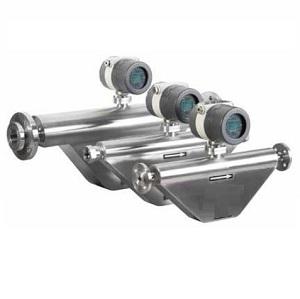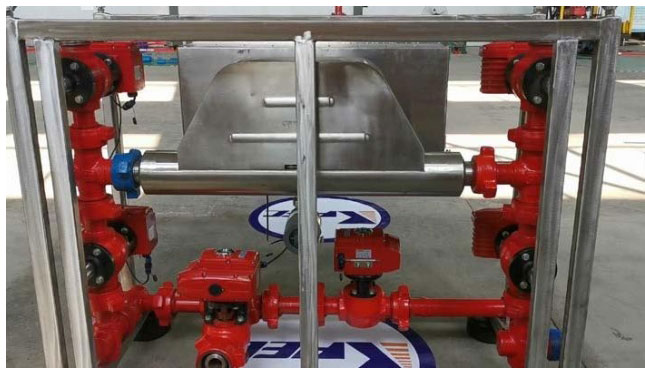Exploring intelligent sensor algorithms How do medidor de flujo coriolis instruments improve fluid system traceability

An innovative Coriolis sensor exploits mechanical effects capitalizing on force interactions to detect flow metrics. While the flow moves in bent chambers, rotational energy produces shifts in fluid pathway, reflective of throughput, allowing dependable fluid quantification. Coriolis meters boast adaptive versatility, suitable for various flow materials with negligible head drop.
- Positive Aspects of Coriolis Flow Meters:
- Superior precision capabilities:
- Broad operational capacity:
- Integrated compositional measurement:
Mastering Coriolis Flowmeter Theory
Coriolis flow instruments embody precise measurement gadgets applied to gauge liquid movement in ductwork. Leveraging rotational dynamics, they assess flow through force-induced distortions. Within oscillating tubes, flow direction displaces sideways, governed by motion direction. Detectors register displacement, encoding path changes as signals aligned with transport magnitude.
- Employments of Coriolis flowmeters include:
- Production control in hydrocarbon sectors
- Food processing
- Sewage management
Choosing Appropriate Instruments
Coriolis meters excel in providing precision for fluid flow analysis. Yet, with an array of available models, selecting the best fit for applications may be involved. Key considerations when securing your Coriolis flow meter include: * **Characteristics of the fluid:** The fluid observed impacts fabrication and performance. * **Flow capacity range:** Meters execute within distinct flow limits. Ensure your needs are met. * **Accuracy standards:** Different use cases call for diverse precision levels. Establish these to narrow down models. * **Operational environment:** Factors such as temperature, pressure, and fluid viscosity alter meter outcomes. * **System compatibility:** Assess integration and attachment with existing infrastructure.Pros of Cutting-Edge Coriolis Flow Measurement
Modern Coriolis devices provide a wide variety of benefits for industrial needs. Primarily, these meters offer highly reliable measurements, facilitating precise fluid observation. In addition, Coriolis meters provide simultaneous mass and density evaluation in one device, making them exceptionally suited for demanding measurement. Furthermore, their resilience enables operation in difficult backgrounds.
- Thus, these devices see broad use in fields like oil and gas, chemicals, food and beverage sectors, and pharmaceuticals.
State-of-the-Art Calibration Practices
Precision-critical contexts prioritize Coriolis flowmeter performance. Ensuring dependable, repeatable results demands modern calibration methods. These exceed basic protocols by integrating expert tools and detailed analysis.
Certified standards guarantee calibration quality. By comparing meter outputs with known benchmarks, technicians detect discrepancies and apply corrections.
- Multi-point calibration, assessing various flow rates, yields comprehensive performance profiling across meter ranges.
- Advanced software assists data management and visualization, enabling data analysis.
Consistent use of advanced calibration ensures optimal meter accuracy, driving productivity boosts across industries.
Diagnosing Standard Coriolis Errors
Coriolis meters provide trusted accuracy and adaptability yet face occasional errors. Early issue identification is vital to reducing downtime and maintaining system reliability. Typical complications involve misalignment, often caused by improper setup, dirty sensing components, or flow disturbances. Sensor jitter may result from changing fluid properties, mechanical vibrations, or electromagnetic disturbances. Effective problem-solving requires thorough examination of conditions, sensor outputs, and operational logs.
- Scheduled maintenance for damage or contamination applies.
- Alignment confirmation maintains accuracy.
- Checking signals aids early detection.
- Appropriate mounting helps reduce interference.
Employing solutions minimizes common Coriolis flowmeter challenges, ensuring reliable fluid monitoring and operational consistency.
Industrial Automation with Coriolis Flow Meters
Flowmeters deliver reliable throughput monitoring within industrial applications. Utilizing the Coriolis effect triggered by fluid passage inside vibrating tubes, movements in tube oscillations correspond to fluid mass rate. This quality enables high-fidelity quantification of mass transport even in complex environments.
They serve well a diverse variety of uses, including chemical processing. Their resilience makes them advantageous for challenging scenarios, and their connected output enables efficient linking with production networks.
Advanced Flow Rate Monitoring with Coriolis Meters
Coriolis sensors deliver robust reliability across multiple applications. They employ moment dynamics to quantify mass flow, yielding highly reliable data under fluctuating flow regimes. As opposed to alternative flow technologies, Coriolis sensors provide persistent readings, facilitating tight process control. Their dual ability to measure mass flow and density makes them ideal for comprehensive flow assessments. Furthermore, Coriolis sensors exhibit durability, thriving in challenging operating backgrounds. This combination of performance qualifies Coriolis sensors as a dominant choice for demanding flow measurement situations.Industrial Metering in Oil & Gas Fields
Coriolis flowmeters have exemplified themselves as reliable tools in the oil and gas field. Their capacity to simultaneously coriolis flujometro measure flow volume and medium concentration renders them multi-functional for many operational tasks. In exploration workflows, Coriolis meters facilitate monitoring petroleum variants in refineries. They also fulfill essential roles in output monitoring and guarantee valid metering for financial settlements.Coriolis Technology in Water Management
Coriolis-based meters equip water systems with precise measurement for detailed assessment in water management contexts. Utilizing mass effect principles, they measure liquid movement through bent tubes. This detailed data permits real-time volume monitoring, key for refining system capability.
- Uses of Coriolis flowmeters in water systems address broad processes, such as: channeling water to homes and industries, recording water consumption for irrigation and renewable energy, and administering water flow in treatment plants.
- Strengths for Coriolis flowmeters in this area present: superior sharpness, broad measurement capability across volumes, and reduced servicing requirements.
Optimizing Fluid Flow Measurement Using Coriolis Technology
Coriolis flowmeters have established themselves as trusted solutions for tracking solutions. These techniques apply the Coriolis effect to evaluate both mass flow and fluid density. Using Coriolis technology can increase measurement accuracy, decrease operating expenses, and provide insightful data about process features. Their applicability enables use in a large range of applications such as manufacturing.
